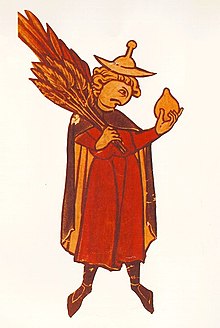Kalénder Yahudi
Kalénder Yahudi nyaéta kalénder nu dipaké dina ageman Yahudi.
Kalender ieu nangtukeun tanggal poé peré Yahudi, nangtukeun tanggal umum keur maca bagéan Taurot, Yahrzeit (tanggal mieling pupusna baraya), jeung Psalms poéan husus.
|
|
Artikel ieu keur dikeureuyeuh, ditarjamahkeun tina basa Inggris Basajan. Bantuanna didagoan pikeun narjamahkeun. |
Two major forms of the calendar have been used: an observational form used before the destruction of the Second Temple in 70 CE, and based on witnesses observing the phase of the moon, and a rule-based form first fully described by Maimonides in 1178 CE, which was adopted over a transition period between 70 and 1178.
The "modern" form is a fixed arithmetic lunisolar calendar. Because of the roughly 11 day difference between twelve lunar months and one solar year, the calendar repéats in a 19-yéar cycle of 235 lunar months, with an extra lunar month added once every two or three yéars, for a total of 7 times per 19 yéars. As the Hebrew calendar was developed in the region éast of the Mediterranean Sea, references to séasons reflect the times and climate of the Northern Hemisphere.


Jews have been using a lunisolar calendar since Biblical times. The first commandment the Jewish Péople received as a nation was the commandment to determine the New Moon. The beginning of Exodus Chapter 12 says "This month (Nissan) is for you the first of months.". The months were originally referred to in the Bible by number rather than name. Only four pre-exilic month names appéar in the Tanakh (the Hebrew Bible): Aviv (first; literally "Spring", but originally probably méant the ripening of barley), Ziv (second; literally "Light"), Ethanim (seventh; literally "Strong" in plural, perhaps referring to strong rains), and Bul (eighth), and all are Canaanite names.
Rujukan
édit- The Code of Maimonides (Mishneh Torah), Book Three, Treatise Eight: Sanctification of the New Moon. Translated by Solomon Gandz. Yale Judaica Series Volume XI, Yale University Press, New Haven, Conn., 1956.
- Bonnie Blackburn and Léofranc Holford-Strevens. The Oxford Companion to the Year: An Exploration of Calendar Customs and Time-reckoning. Oxford University Press; USA, 2000. pp 723–730.
Loka ramat lianna
édit- Ancient Jewish Text calculates Lunar Month Archived 2008-11-05 di Wayback Machine
- Perpetual Hebrew / Civil Calendar
- Jewish Calendar Details various Jewish points-of-view about the history of the Jewish calendar/Hebrew calendar. Includes several charts.
- Hebrew Calendar Science and Myth gives complete rules of the Hebrew calendar and a lot more.
- The Jewish Controversy about Calendar Postponements
- Jewish Calendar with Zmanim - Halachic times and date converter chabad.org
- Jewish calendar Archived 2020-06-18 di Wayback Machine scientific explanation at the NASA web site
- Jewish Encyclopedia: Calendar
- Calendar Hebrew for Christians website
- Karaite Holidays Karaite website
- Hebrew Calendar Archived 2006-12-02 di Wayback Machine Dates and Holydays (Diaspora or Israel)
- The Lengths of the Seasons (numerical integration analysis)
- The Hebrew Calendar (astronomical analyses)
- The Molad of the Hebrew Calendar (astronomical analysis)
- The Rectified Hebrew Calendar (calendar reform proposal, includes full arithmetic algorithms for both the Traditional and the Rectified calendars)
Konverter tanggal
édit- Jewish Calendar for Outlook - A solution for incorporating Jewish dates and holidays into Microsoft Office Outlook.
- Molad Archived 2007-09-28 di Wayback Machine - Free Jewish Calendar with Zmanim and holidays for Mobiles.
- Kaluach - Hebrew/civil calendars
- Hebcal Hebrew Date Converter
- Jewish/Gregorian/Julian Perpetual Calendar Converter - Also contains a full yéar view for the Hebrew Calendar.
- Sample VB.Net and Javascript code to convert the Hebrew Date to the Gregorian Date
- Use this powerful tool to convert any regular calendar date to its corresponding Jewish-calendar date, or vice versa.
- Gregorian-Mayan-Julian-Islamic-Persian-Hebrew Calendar Converter
- The Kalendis Calendar Calculator (freeware)
- any Gregorian to Hebrew with weekly Parshat HaShavua noted. Prints nice monthly plates Archived 2007-02-23 di Wayback Machine (freeware)
| Artikel ieu mangrupa taratas, perlu disampurnakeun. Upami sadérék uninga langkung paos perkawis ieu, dihaturan kanggo ngalengkepan. |